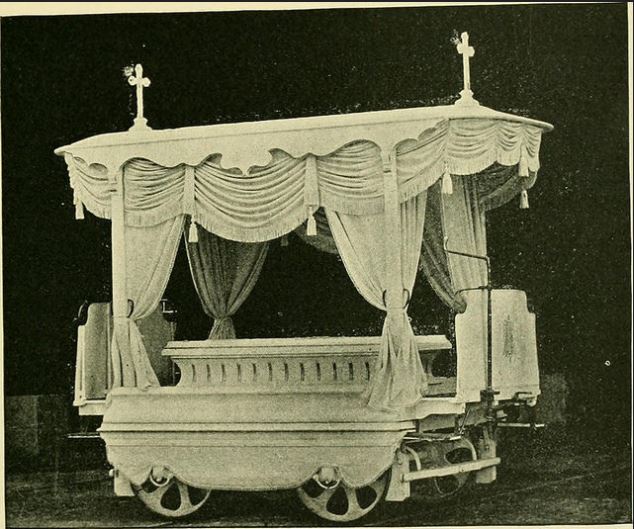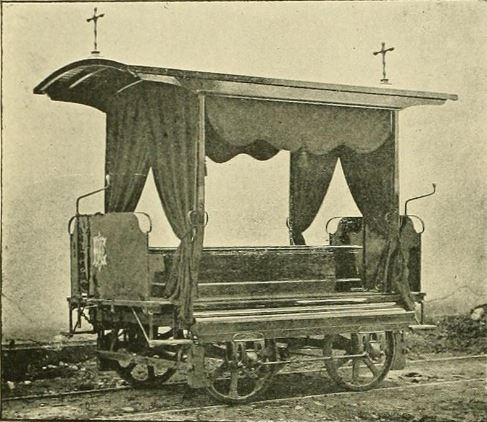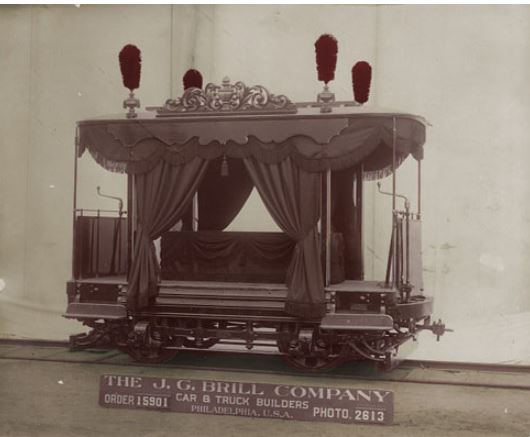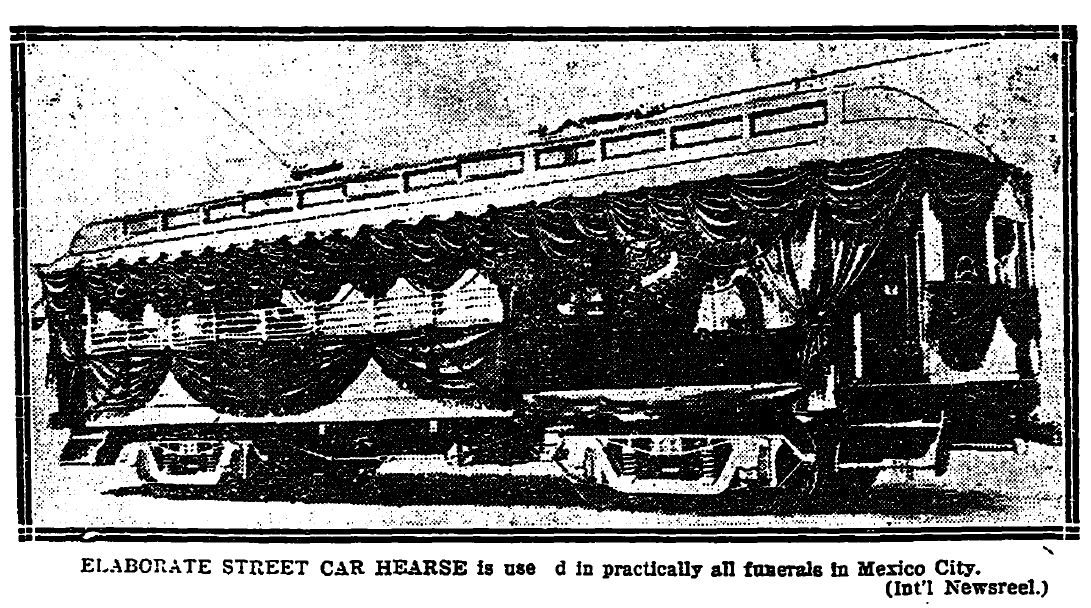Hell-wain Spotting

Hell-wain Spotting White trolley hearse for child funerals, 1891
Dia de los Muertos begins today. I hope you have your ofrendas decorated and have laid in a good supply of sugar skulls and marigolds. Although I’ve previously told ghost stories about dead nuns and sinister ravens and corpse-confessors to celebrate, this year I’d like to visit the fascinating world of Hispanic street-car hearses. They are perhaps, not strictly speaking hell-wains, the common carrier for the souls of the damned, but rather vehicles for Purgatorial passage. (Incidentally, I had thought about calling this post “A Streetcar Named ‘The Crier.'” There was a funeral street car in Baltimore christened “Dolores.”)
While trolley hearses were used in the United States, there did not seem to be as much enthusiasm about the idea as there was in Mexico and South America where they were seen as a modern innovation and a symbol of progressive government policies towards the poor, offering various levels of service and conveying the bodies of paupers to the grave without charge.
Despite the egalitarian public’s fondness for private funeral trains and carriages in the United States, the press seemed fascinated by this “class system” of Mexican funerals. The trolley funerals were often the subject of “curious customs from our neighbors to the south” articles, complete with the casual racism of the time. I’ll caution you that there will be a bit of overlap with the articles here because I’m a completist when it comes to documenting mortuary history.
Here we see how the trolley hearses did not start out as a program of government beneficence, but as a capitalist venture.

First Class Funeral Car 1884
FUNERALS ON STREET CARS
When the street-car line was first opened in [the City of] Mexico an enterprising stockholder, Senor Gayosso, bought up all the hearses in the city. He then had funeral cars built for the tracks and procured the sole right to prepare passengers and haul them to their last resting-place. He is to-day one of the wealthiest men in Mexico. The first-class funeral cars for adults are built of fine black wood. A raised part is in the center of the car on which the coffin is placed. A canopy, exquisitely finished, covers the entire car, the sides being artistically draped. From four to eight beautiful black horses, with long, black plumes in their heads, haul this strange car.
The two drivers are dressed in fine black suits, gloves and high silk hats, bound with wide crepe bands. The coffin is placed on the rest prepared for it, and all around and over flowers are placed. Following this comes a train of cars with the friends. The windows are draped with white crepe and the doors with black. A funeral train will average twenty cars and more, if it is a person of wealth who has died. But in the hundreds who follow a body to the grave cannot be found one woman or child.
I have asked the reason why no women ever attend funerals in Mexico. It is against the rules of society. Mr. Gayosso says women are not allowed to go to funerals because they cry too much. However, a wife cannot go to her husband’s funeral, nor can a mother follow her babe to its grave.
There is a similarity in all the funeral cars. Those for children are white, drawn by white horses. Those for the poor are, like other things in this world for the poor, cheap and shabby. The poor Indian can have a funeral-car and two passage tickets for fifty cents by applying to the police. He can even hire a plain, unpainted coffin to carry the dead to the grave. Once there, the body is wrapped in a serape and consigned to a grave which has been rented for from two to five years. At the end of that time the grave is opened and the bleaching bones are cast into a corner kept for that purpose, where they lay bleaching in the hot Southern sun, exposed to the gaze of the public.
Funerals cost from fifty cents to $2,000. One of the prettiest customs in Mexico is the universal respect which greets a passing funeral. Every man, from the millionaire to the poor, half-clad peon, takes off his hat until the sad train is passed. Well-dressed senoras bow their head and silently cross themselves, while the Indian women kneel in prayer. Cincinnati [OH] Enquirer 21 May 1887: p. 15
Even today “Agencias Funerarias Gayosso” appears to be one of the most prominent funeral directors in Mexico.

The cheapest class of funeral car, except for the multi-compartmented one for pauper funerals. 1891
Among the poor, there was a custom of carrying the coffin to the cemetery by hand or on the head.
The Mexicans have a queer way of burying the dead. The corpse is tightly wrapped in century plant matting, and placed in a coffin rented for about twenty-five cents. One or two natives, as the case may be, place the coffin on their heads and go in a trot to the grave, where the body is interred, and the coffin is then returned. The wealthy class use the street cars as hearses, and the friends follow behind the cars on foot. Evening News [San Jose, CA] 23 February 1889: p. 3
Elaborate street car hearse, 1923
The funeral trolleys were quite the lucrative business.
FUNERAL SERVICE.
The story of the splendid street car service given the city of Mexico would hardly be complete without giving a short description of the funeral service. There is a special department for this service, which is very much used, and which earns, I am told, about $400 per day. For this service the old horse cars are used to a good advantage. The company controls the funeral service of the city, whether it be by electric car, horse car or carriage, and it is prepared to furnish any kind of service upon short notice given at their office.
With few exceptions the funerals from the city to the cemeteries are conducted by the street railway company, either first-class, second-class or free, the cost varying with the amount of decoration used on the cars. It is not an uncommon sight to see five or six funerals leaving the public square, following one another on the street railway tracks, each with from one to three cars. Some have great quantities of beautiful flowers and ornamentation and others have none.
The funeral car is generally a motor car, but sometimes it is pulled by mules. It is painted and trimmed in black or white. All are single-truck cars, with four square posts supporting the roof at the corners of the car body, forming a parallelogram, say 12 feet long by the usual width of the car. Between the posts on the floor of the car is a raised portion upon which the casket and many of the flowers are placed. The friends of the dead are carried in one, two or three trailers or horse cars. I have seen as many as two trailers filled with floral decorations.
There are also two magnificently furnished and fitted cars called “Carrozas” for extraordinarily fine funerals. These cars cost upward of $10,000 each and have a place in front for the casket, with seats behind for the people. Women never attend funerals in this country. They also have 20 electric and 8 horse “Carrozas,” which are used for first and second class funerals, according as may be required and are decorated to suit for extra expense. The original cost of such a car is $3.75 silver, trailers being paid for at the same rate,
This service saves the people many thousands of dollars annually and at the same time is worthwhile to the railway company.
The free car for funerals when people are unknown or die absolutely destitute is quite another thing; instead of being entirely open it is entirely closed, with doors on one side opening from top to bottom. There are four doors, with three compartments to each (like pigeonholes), there being 12 places in each car. In each one of these places a body is placed, either in a common board coffin or sewed up in a blanket. The latter cars are furnished at the exact cost of running, twice per day. The service is paid for by the government. Electric Railway Review, Volume 19, 14 March 1908: p. 326
The trolleys were even mentioned in the papers and in guidebooks as one of the not-to-be-missed tourist attractions of Mexico City. I was interested to note that the information on trolley-hearses from an 1899 guide to Mexico was copied practically word-for-word by a 1911 travel book—a long run of popularity.

1st Class Funeral Motor Body for Guinle & Company of Bahia, Brazil
(Photo #2613, Order #15901–Ordered March 16, 1907, Delivered June 15, 1907)
This photo depicts an open, ornate funeral car with a platform for a casket at the center of the car, draped in black cloth. The sides of the car have heavy black drapes held open with tiebacks, and there are four black plumes on each corner of the roof..
http://www2.hsp.org/collections/manuscripts/brill/inventory.htm
MEXICO’S TROLLEY FUNERALS
Train of Electric Hearses and Mourners’ Cars One of Sights.
City of Mexico, June 27.
The elaborate funeral processions which, winding gay-colored through the streets, are a feature of most Spanish-American countries, are unknown here. The electric trains are used for all funerals and the procession following the dead to the place of burial is as modern and up to date as it can be. The electric trains of Mexico are well built and run, their direction being in the hands of Americans and Englishmen. One of the main lines runs to the principal cemetery of the city and along this all the funerals go.
The company has a contract with the city under the terms of which a special burial car, containing coffins for twelve bodies, calls daily at the hospitals and public institutions to take the city charges who have died to the city cemetery. Under the contract with the city the trolley company furnishes the hearse and the car crew, and the undertakers are city employes. The funeral car is a plain black car with little ornamentation.
The company has for private use several cars ranging in elaborateness from a plain style, for which a small charge is made, to a very elaborate one, the price of which puts it beyond the reach of all but the well-to-do.
All the cars are so constructed that they can be run off the tracks and over the pavements to the house from which the body is to be taken. When the coffin is secured the car is drawn by horses back to the nearest track, where it make the necessary electric connection.
Of late the government has been repaving the streets with asphalt. It has been found that dragging the heavy funeral cars over this is ruinous to the pavement and soon another arrangement will be necessary. The trolley company intends to have a central funeral station designated, into which the electric hearses can run on spurs and to which the dead will be taken in vehicles provided for that purpose. A familiar sight on the trolley line to the cemetery is a funeral train made up of an electric hearse, with a trailer for the mourners; another hearse, with another body, another trailer, with another party of mourners, and so on. The trains run at the same speed as other electric vehicles.
Many of the hearses are elaborately embellished with statuettes, carved work, plumes, torches and similar emblems of mourning. The trolley company finds the business profitable and it is growing all the time. Grand Rapids [MI] Press 27 June 1903: p. 10
This pretty picture of funereal efficiency was rather marred by darker reports of ill-maintained tramways, which caused derailments and the spilling of corpses into the street. The admirable plan to collect pauper corpses from the hospitals with Prussian precision was tempered by the reality that the trolley did not always run on time and there were both backlogs of rotting bodies at the cemeteries and complaints by the dismayed populace of naked and decomposing bodies and body parts being run through the middle of Mexico City during the day. In addition, in 1904 there were complaints that a pulqueria across the street from the Panteon Civil de Dolores was patronized by mourners and trolley drivers, who then drove recklessly through the cemetery.
The Mexican Civil War caused the destruction of many trolley lines. The article below suggests that the Mexican trolley-hearse was on the wane. Note that the headquarters of the Mexico Tramways Company was in Canada, perhaps a remnant of those “Englishmen” who were said to have built and run it in 1903.
FUNERAL TRAINS IDLE
Toronto, Ont., Jan. 24. At his desk in Toronto, an official of the Mexico Tramways Company recently noted statistics showing that the street car hearse business in Mexico City had been dropping off gradually during recent years. Hence, an order has gone forth from the Toronto headquarters of the Mexican city’s street car system that its “funeral trains” no longer are to be operated. Times-Picayune [New Orleans LA] 25 January 1931: p. 20
It seems as though trolley-hearses still ran in San Francisco through the late 1920s. Does anyone know the date of the latest use of a trolley hearse either in Mexico or the United States? Bier-heads welcome. Chriswoodyard8 AT gmail.com
For a really fascinating look at the historical care of the dead in Mexico City, see “The Cadaverous City: The Everyday Life of the Dead in Mexico City: 1875-1930.”
Chris Woodyard is the author of The Victorian Book of the Dead, The Ghost Wore Black, The Headless Horror, The Face in the Window, and the 7-volume Haunted Ohio series. She is also the chronicler of the adventures of that amiable murderess Mrs Daffodil in A Spot of Bother: Four Macabre Tales. The books are available in paperback and for Kindle. Indexes and fact sheets for all of these books may be found by searching hauntedohiobooks.com. Join her on FB at Haunted Ohio by Chris Woodyard or The Victorian Book of the Dead.

